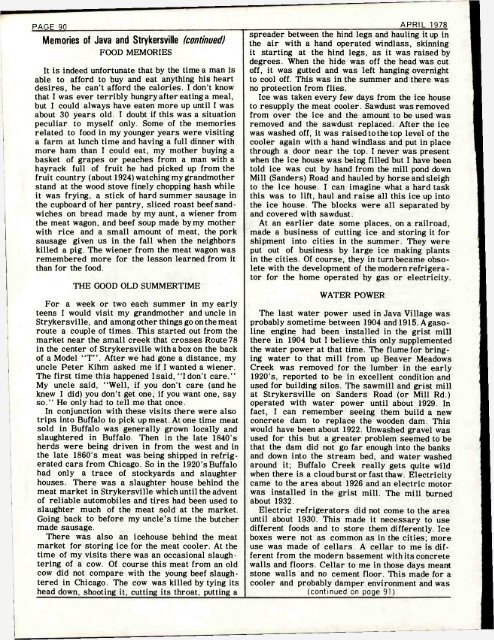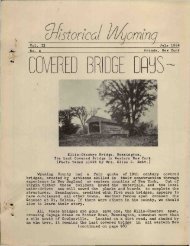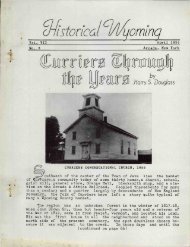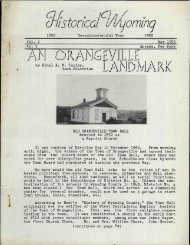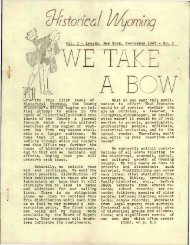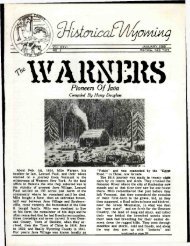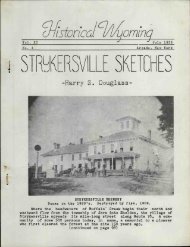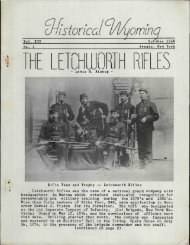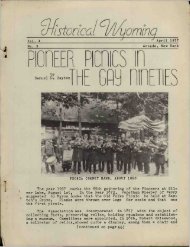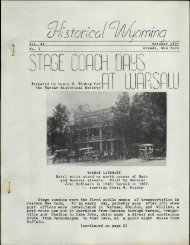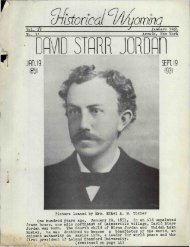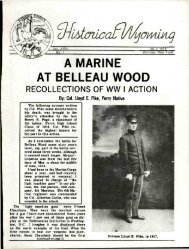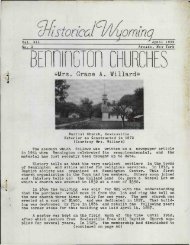By C. Kihm Richardson Walking from Strykersville ... - Fulton History
By C. Kihm Richardson Walking from Strykersville ... - Fulton History
By C. Kihm Richardson Walking from Strykersville ... - Fulton History
You also want an ePaper? Increase the reach of your titles
YUMPU automatically turns print PDFs into web optimized ePapers that Google loves.
PAGE 90<br />
Memories of Java and <strong>Strykersville</strong> (continued)<br />
FOOD MEMORIES<br />
It is indeed unfortunate that by the time a man is<br />
able to afford to buy and eat anything his heart<br />
desires, he can't afford the calories. I don't know<br />
that I was ever terribly hungry after eating a meal,<br />
but I could always have eaten more up until I was<br />
about 30 years old. I doubt if this was a situation<br />
peculiar to myself only. Some of the memories<br />
related to food in my younger years were visiting<br />
a farm at lunch time and having a full dinner with<br />
more ham than I could eat, my mother buying a<br />
basket of grapes or peaches <strong>from</strong> a man with a<br />
hayrack full of fruit he had picked up <strong>from</strong> the<br />
fruit country (about 1924) watching my grandmother<br />
stand at the wood stove finely chopping hash while<br />
it was frying, a stick of hard summer sausage in<br />
the cupboard of her pantry, sliced roast beef sandwiches<br />
on bread made by my aunt, a wiener <strong>from</strong><br />
the meat wagon, and beef soup made by my mother<br />
with rice and a small amount of meat, the pork<br />
sausage given us in the fall when the neighbors<br />
killed a pig. The wiener <strong>from</strong> the meat wagon was<br />
remembered more for the lesson learned <strong>from</strong> it<br />
than for the food.<br />
THE GOOD OLD SUMMERTIME<br />
For a week or two each summer in my early<br />
teens I would visit my grandmother and uncle in<br />
<strong>Strykersville</strong>, and among other things go on the meat<br />
route a couple of times. This started out <strong>from</strong> the<br />
market near the small creek that crosses Route 78<br />
in the center of <strong>Strykersville</strong> with a box on the back<br />
of a Model "T". After we had gone a distance, my<br />
uncle Peter <strong>Kihm</strong> asked me if I wanted a wiener.<br />
The first time this happened I said, "I don't care."<br />
My uncle said, "Well, if you don't care (and he<br />
knew I did) you don't get one, if you want one, say<br />
so." He only had to tell me that once.<br />
In conjunction with these visits there were also<br />
trips into Buffalo to pick up meat. Atone time meat<br />
sold in Buffalo was generally grown locally and<br />
slaughtered in Buffalo. Then in the late 1840's<br />
herds were being driven in <strong>from</strong> the west and in<br />
the late 1860's meat was being shipped in refrigerated<br />
cars <strong>from</strong> Chicago. So in the 1920's Buffalo<br />
had only a trace of stockyards and slaughter<br />
houses. There was a slaughter house behind the<br />
meat market in <strong>Strykersville</strong> which until the advent<br />
of reliable automobiles and tires had been used to<br />
slaughter much of the meat sold at the market.<br />
Going back to before my uncle's time the butcher<br />
made sausage.<br />
There was also an icehouse behind the meat<br />
market for storing ice for the meat cooler. At the<br />
time of my visits there was an occasional slaughtering<br />
of a cow. Of course this meat <strong>from</strong> an old<br />
cow did not compare with the young beef slaughtered<br />
in Chicago. The cow was killed by tying its<br />
head down, shooting it, cutting its throat, putting a<br />
APRIL 1978<br />
spreader between the hind legs and hauling it up in<br />
the air with a hand operated windlass, skinning<br />
it starting at the hind legs, as it was raised by<br />
degrees. When the hide was off the head was cut<br />
off, it was gutted and was left hanging overnight<br />
to cool off. This was in the summer and there was<br />
no protection <strong>from</strong> flies.<br />
Ice was taken every few days <strong>from</strong> the ice house<br />
to resupply the meat cooler. Sawdust was removed<br />
<strong>from</strong> over the ice and the amount to be used was<br />
removed and the sawdust replaced. After the ice<br />
was washed off, it was raised to the top level of the<br />
cooler again with a hand windlass and put in place<br />
through a door near the top. I never was present<br />
when the ice house was being filled but I have been<br />
told ice was cut by hand <strong>from</strong> the mill pond down<br />
Mill (Sanders) Road and hauled by horse and sleigh<br />
to the ice house. I can imagine what a hard task<br />
this was to lift, haul and raise all this ice up into<br />
the ice house. The blocks were all separated by<br />
and covered with sawdust.<br />
At an earlier date some places, on a railroad,<br />
made a business of cutting ice and storing it for<br />
shipment into cities in the summer. They were<br />
put out of business by large ice making plants<br />
in the cities. Of course, they in turn became obsolete<br />
with the development of the modern refrigerator<br />
for the home operated by gas or electricity.<br />
WATER POWER<br />
The last water power used in Java Village was<br />
probably sometime between 1904 and 1915. A gasoline<br />
engine had been installed in the grist mill<br />
there in 1904 but I believe this only supplemented<br />
the water power at that time. The flume for bringing<br />
water to that mill <strong>from</strong> up Beaver Meadows<br />
Creek was removed for the lumber in the early<br />
1920's, reported to be in excellent condition and<br />
used for building silos. The sawmill and grist mill<br />
at <strong>Strykersville</strong> on Sanders Road (or Mill Rd.)<br />
operated with water power until about 1929. In<br />
fact, I can remember seeing them build a new<br />
concrete dam to replace the wooden dam. This<br />
would have been about 1922. Unwashed gravel was<br />
used for this but a greater problem seemed to be<br />
that the dam did not go far enough into the banks<br />
and down into the stream bed, and water washed<br />
around it; Buffalo Creek really gets quite wild<br />
when there is a cloud burst or fast thaw. Electricity<br />
came to the area about 1926 and an electric motor<br />
was installed in the grist mill. The mill burned<br />
about 1932.<br />
Electric refrigerators did not come to the area<br />
until about 1930. This made it necessary to use<br />
different foods and to store them differently. Ice<br />
boxes were not as common as in the cities; more<br />
use was made of cellars. A cellar to me is different<br />
<strong>from</strong> the modern basement with its concrete<br />
walls and floors. Cellar to me in those days meant<br />
stone walls and no cement floor. This made for a<br />
cooler and probably damper environment and was<br />
(continued on page 91)


